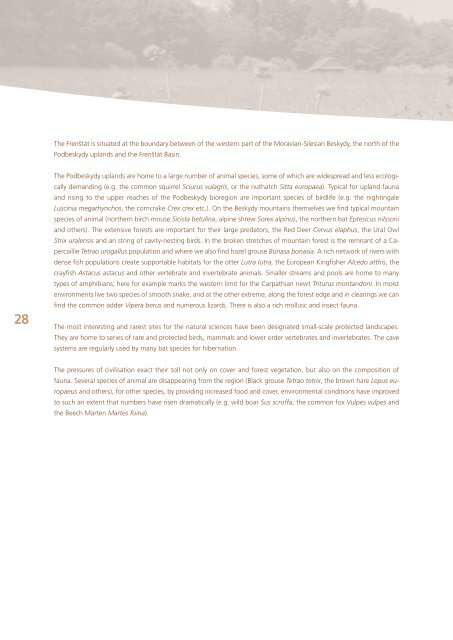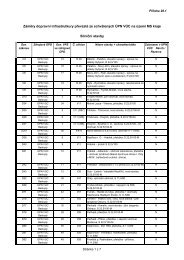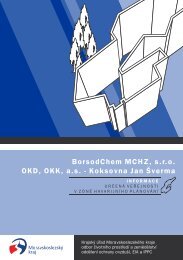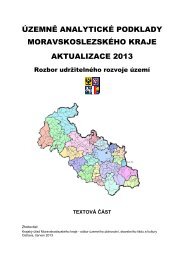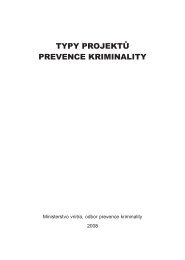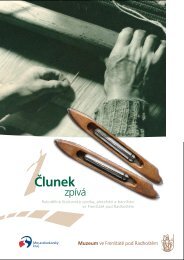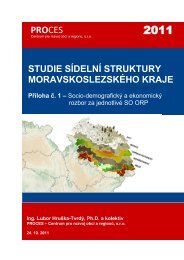Doteky pÅÃrody - Moravskoslezský kraj
Doteky pÅÃrody - Moravskoslezský kraj
Doteky pÅÃrody - Moravskoslezský kraj
You also want an ePaper? Increase the reach of your titles
YUMPU automatically turns print PDFs into web optimized ePapers that Google loves.
The Frenštát is situated at the boundary between of the western part of the Moravian-Silesian Beskydy, the north of the<br />
Podbeskydy uplands and the Frenštát Basin.<br />
28<br />
The Podbeskydy uplands are home to a large number of animal species, some of which are widespread and less ecologically<br />
demanding (e.g. the common squirrel Sciurus vulagris, or the nuthatch Sitta europaea). Typical for upland fauna<br />
and rising to the upper reaches of the Podbeskydy bioregion are important species of birdlife (e.g. the nightingale<br />
Luscinia megarhynchos, the corncrake Crex crex etc.). On the Beskydy mountains themselves we find typical mountain<br />
species of animal (northern birch mouse Sicista betulina, alpine shrew Sorex alpinus, the northern bat Eptesicus nilssoni<br />
and others). The extensive forests are important for their large predators, the Red Deer Cervus elaphus, the Ural Owl<br />
Strix uralensis and an string of cavity-nesting birds. In the broken stretches of mountain forest is the remnant of a Capercaillie<br />
Tetrao urogallus population and where we also find hazel grouse Bonasa bonasia. A rich network of rivers with<br />
dense fish populations create supportable habitats for the otter Lutra lutra, the European Kingfisher Alcedo atthis, the<br />
crayfish Astacus astacus and other vertebrate and invertebrate animals. Smaller streams and pools are home to many<br />
types of amphibians; here for example marks the western limit for the Carpathian newt Triturus montandoni. In moist<br />
environments live two species of smooth snake, and at the other extreme, along the forest edge and in clearings we can<br />
find the common adder Vipera berus and numerous lizards. There is also a rich mollusc and insect fauna.<br />
The most interesting and rarest sites for the natural sciences have been designated small-scale protected landscapes.<br />
They are home to series of rare and protected birds, mammals and lower order vertebrates and invertebrates. The cave<br />
systems are regularly used by many bat species for hibernation.<br />
The pressures of civilisation exact their toll not only on cover and forest vegetation, but also on the composition of<br />
fauna. Several species of animal are disappearing from the region (Black grouse Tetrao tetrix, the brown hare Lepus europaeus<br />
and others), for other species, by providing increased food and cover, environmental conditions have improved<br />
to such an extent that numbers have risen dramatically (e.g. wild boar Sus scroffa, the common fox Vulpes vulpes and<br />
the Beech Marten Martes foina).


